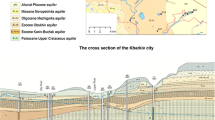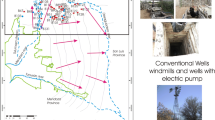Abstract
The impact of urbanization on groundwater quality is of special concern for water managers dealing with the provision of drinking water to large urban centers. Nitrate is one of the most common contaminants found in urban aquifers. This paper presents a case study aiming at evaluating the distribution and sources of nitrate in an urban aquifer in the city of Mar del Plata, Argentina. Four study zones under different land uses, including a pristine, a semi-rural, an intermediate, and an urban area, were evaluated as a part of this study. The three latter zones are linked by the groundwater flow system. The average nitrate concentration in the pristine area is 6.7 mg/L as nitrate and is over the permissible level of 50 mg/L for drinking water in the other areas. In the semi-rural area it ranges from 39.2 to 107.1 mg/L with an average value of 38.2 mg/L and the nitrate concentration tends to decrease in the intermediate zone to an average value of 38.2 mg/L; however, values above 60 mg/L are also observed there. Then the nitrate concentration in the urban area water is higher than that in the intermediate zonewater ranging from 48.2 to 100.3 mg/L with an average value of 67.3 mg/L. Data on the stable isotopes 15N and 18O in nitrate show that the main sources of nitrate in the study area are manure associated to agriculture uses and cesspools in the semi-rural area, and leakage of the sewage distribution network in the urban area, respectively. This is supported by a previous study which found that 20 % of the water flooding many underground structures in the city came from leakage of the sewage network. No evidence of nitrate attenuation by denitrification was found in the groundwater. This study has shown that aquifers in urban areas can be affected by agricultural activity in the upstream areas and leakage of the sewage network in the urban area.






Similar content being viewed by others
References
Amberger A, Schmidt HL (1987) Naturliche Isotopengehalte von Nitrat als Indikatoren fur dessen Herkunft. Geochimica Cosmochimica Acta 51:2699–2705
APHA, AWWA, WEF (1998) Standard methods for the examination of water and wastewater, 20th edn. American Public Health Association, Washington, DC
Aravena R, Robertson W (1998) The use of multiple isotope tracers to evaluate denitrification in groundwater: a case study in a large septic system plume. Ground Water 36:975–982
Aravena R, Evans ML, Cherry JA (1993) Stable isotopes of oxygen and nitrogen in source identification of nitrate from septic systems. Ground Water 31:180–186
Bocanegra EM, Martínez DE, Massone HE, Cionchi JL (1993) Exploitation effect and salt water intrusion in the Mar del Plata Aquifer, Argentina. In: Custodio E, Galofré A (eds) Study and modelling of salt water intrusion into aquifers. CIMNE-UPC, Barcelona, pp 177–191. ISBN 84-87867-26-X
Bocanegra E, Massone HE, Martínez DE, Civit E, Farenga M (2001) Groundwater contamination: risk management and assessment for landfills in Mar del Plata, Argentina. Environ Geol 40(6):732–741
Bocanegra EM, Martínez DE, Carrera J, Pool M, Ferrante A (2010) Determination of water sources for underground structures flooding in Mar del Plata, Argentina, applying mixing indexes. XXXVIII IAH Congress, proceedings, ISSN 0208-6336, ISBN 978-83-226-1979-0. 306–3011
Böhlke JK, Denver JM (1995) Combined use of groundwater dating, chemical, and isotopic analyses to resolve the history and fate of nitrate contamination in two agricultural watersheds, Atlantic Coastal Plain, Maryland. Water Resour Res 31:2319–2339
Böttcher J, Strebel O, Voerkelius S, Schmidt HL (1990) Using isotope fractionation of nitrate-nitrogen and nitrate-oxygen for evaluation of microbial denitrification in a sandy aquifer. J Hydrol 114:413–424
Chebotarev II (1955) Metamorphism of natural waters in the crust of weathering. Geochimica Cosmochimica Acta 8:22–48
Cionchi JL (1994) El estado actual de los acuíferos en el barrio Parque Hermoso y zonas adyacentes (Partido de General Pueyrredón). OSSE. Technical unpublished report
Cionchi JL, Redín RI (2004) La contaminación del agua subterránea producida por las deficiencias constructivas en las perforaciones. OSSE. Technical unpublished report
Código Alimentario Argentino (Argentinian Food Code) (2012) Law 18284, chapter XII, non alcoholic beverages. Hidric beverages, water and sparkling water, arts. 982–1079
Durka W, Schulze ED, Gebauer G, Voerkelius S (1994) Effects of forest decline on uptake and leaching of deposited nitrate determined from 15-N and 18-O measurements. Nature 372:765–767
Fukada T, Hiscock KM, Dennis PF (2004) A dual-isotope approach of the nitrogen hydrochemistry of an urban aquifer. Appl Geochem 19:709–719
Ging PB, Lee RW, Silva SR (1996) Water chemistry of Shoal Creek and Waller Creek, Austin, Texas, and potential sources of nitrate. U S Geol Surv Water Resour Invest Rep 96–4167
Gonfiantini R (1978) Standards for stable isotope measurements in natural compounds. Nature 271:534–536
Hallberg GR, Keeney (1993) Nitrate. In: William A (ed) Regional ground-water quality. Van Nostrand Reinhold, New York, pp 297–322
Kendall C (1998) Tracing nitrogen sources and cycling in catchments. In: Kendall C, McDonnell JJ (eds) Isotope tracers in catchment hydrology. Elsevier, Amsterdam, pp 519–576
Kendall C, Campbell DH, Burns DA, Shanley JB (1997) Oxygen and nitrogen isotope studies of nitrates in watershed studies in the USA: what have we learned? EOS Trans AGU 78(17):169
Korom SF (1992) Natural denitrification in the saturated zone: a review. Water Resour Res 28:1657–1668
Krouse HR (1980) Sulphur isotopes in our environment. In: Fritz P, Fontes JCh (eds) Isotope geochemistry, vol 1., The terrestrial environmentElsevier, Amsterdam, pp 435–471
Mariotti A (1986) Denitrification in groundwaters, principles and methods for its identification: a review. J Hydrol 88:1–23
Martínez DE, Bocanegra EM (2002) Hydrogeochemistry and cationic exchange processes in the coastal aquifer of Mar del Plata, Argentina. Hydrogeol J 10(3):393–408
Martinez D, Bocanegra EM, Costa J (1997) Significado de la correlación pH/\({\rm NO}_{3}{}^{{-}}\)/Ca2+/Mg2+ en aguas subterráneas del sudeste de la provincia de Buenos Aires. I Congreso Nacional de Hidrogeología, Actas Bahía Blanca, 9–12 Sep 1997, pp 193–210
Martínez DE, Dapeña C, Betancur Vargas T, Panarello HO, Quiroz Londoño OM, Massone HE (2007) Environmental isotopes in the water cycle in the catchment of the Quequen Grande River, Argentina. In: International symposium on advances in isotope hydrology and its role in sustainable water resources management. International Atomic Energy Agency (IHS–2007), proceedings, vol. 1, Vienna, Austria, 21–25 May 2007, pp 381–388
Massone HE, Martínez DE, Cionchi JL, Bocanegra EM (1998) Suburban areas in developing countries and its relation with groundwater pollution. Mar del Plata (Argentina) as a study case. Environmental management, ISSN: 0364-152X 22(2), 245–254
Moschione E (2010) Integral assesment of the problem of nitrate in groundwater in the south-east of Buenos Aires Province, Argentina. Alternatives for treatment and reclamation with available technologies. MSc-Thesis Work, Environmental Engineering Masters Degree, National Technological University (UTN), Buenos Aires Regional Faculty
Poiré DG, Spalletti LA, del Valle A (2003) The Cambrian-Ordovician siliciclastic platform of the Balcarce Formation (Tandilia System, Argentina): facies, trace fossils, palaeoenvironments and sequence stratigraphy. Geologica Acta 1(1):41–60
Quiroz Londoño OM, Martínez DE, Dapeña C, Massone HE (2008) Hydrogeochemistry and isotopes of groundwater in low gradients catchments of the province of Buenos Aires, Argentina. Hydrogeol J 16(6):1113–1127
Romanelli A, Quiroz Londoño OM, Martinez DE, Massone HE, Escalante A (2014) Hydrogeochemistry and isotope techniques to determine water interactions in groundwater-dependent shallow lakes, Wet Pampa Plain, Argentina. Environ Earth Sci 71(4):1593–1966
Schubert C, Knobeloch L, Anderson H, Warzecha C, Kanarek M (1997) Nitrate contaminated drinking water followback study, submitted to the WI Department of Natural Resources and the WI Groundwater Coordinating Council. Department of Preventive Medicine, University of Wisconsin-Madison and the WI Department of Health and Family Services
Silva SR, Ging PB, Lee RW, Ebbert JC, Tesoriero AJ, Inkpen EL (2002) Forensic applications of nitrogen and oxygen isotopes in tracing nitrate sources in urban environments. Environ Forensics 3:125–130
Spalding RF, Exner ME (1993) Occurrence of nitrate in groundwater—a review. J Environ Qual 22:392–402
Strebel OJ, Bottcher J, Fritz P (1990) Use of isotope fractionation of sulfate-sulfur and sulfate-oxygen to assess bacterial desulfurication in a sandy aquifer. J Hydrol 121:155–172
US Environmental Protection Agency (EPA) (1997) Integrated Risk Information System (IRIS). April 1997 076 Nitrate. http://www.epa.gov/iris/subst/0076.htm
Vomocil JA (1987) Fertilizers; Best management practices to control nutrients in processing of the northwest non-point source pollution conference Olympia, WA Department of Social and Health Service Washington, LD-II, 24–25 March, pp 88–97, 1987
Ward MH, Mark SD, Cantor KP, Weisenburger DD, Correa-Villasenor A, Zahm SH (1996) Drinking water nitrate and the risk of non-Hodgkin’s lymphoma. Epidemiology 7:465–471
Wassenaar LI (1995) Evaluation of the origin and fate of nitrate in the Abbotsford Aquifer using the isotopes of N-15 and O-18 in nitrate. Appl Geochem 10:391–405
Acknowledgments
The authors are grateful to Universidad Nacional de Mar del Plata, Universidad Tecnologica Nacional (UTN), CONICET and Mar del Plata’s Water Supply and Sanitation Company for their support and facilities. The International Atomic Energy Agency (IAEA) provides funding for nitrogen isotopes analysis and a constant support to the research activities. The contribution of the reviewers was very helpful for the manuscript improvement.
Author information
Authors and Affiliations
Corresponding author
Rights and permissions
About this article
Cite this article
Martínez, D., Moschione, E., Bocanegra, E. et al. Distribution and origin of nitrate in groundwater in an urban and suburban aquifer in Mar del Plata, Argentina. Environ Earth Sci 72, 1877–1886 (2014). https://doi.org/10.1007/s12665-014-3096-x
Received:
Accepted:
Published:
Issue Date:
DOI: https://doi.org/10.1007/s12665-014-3096-x




